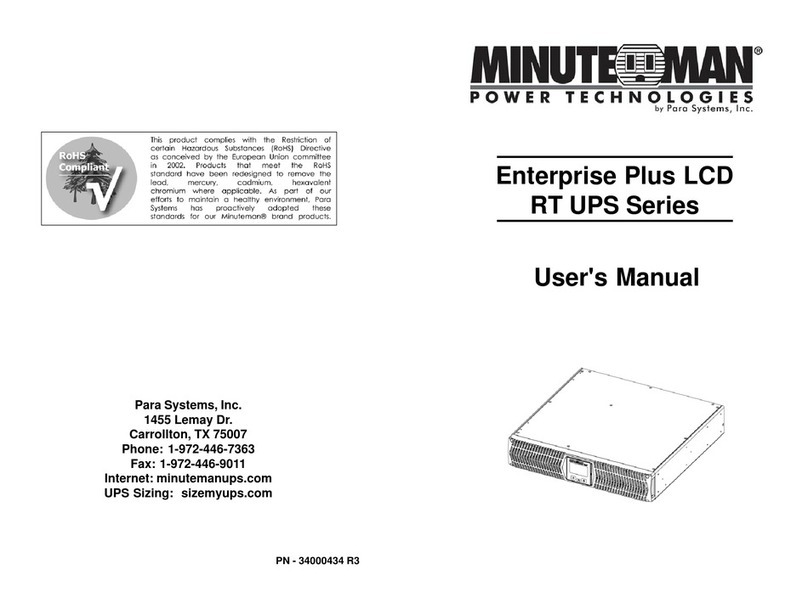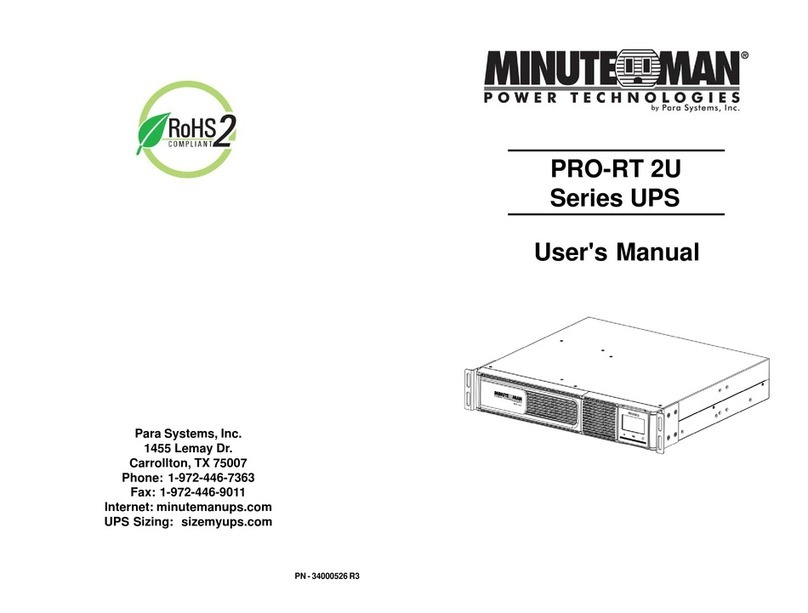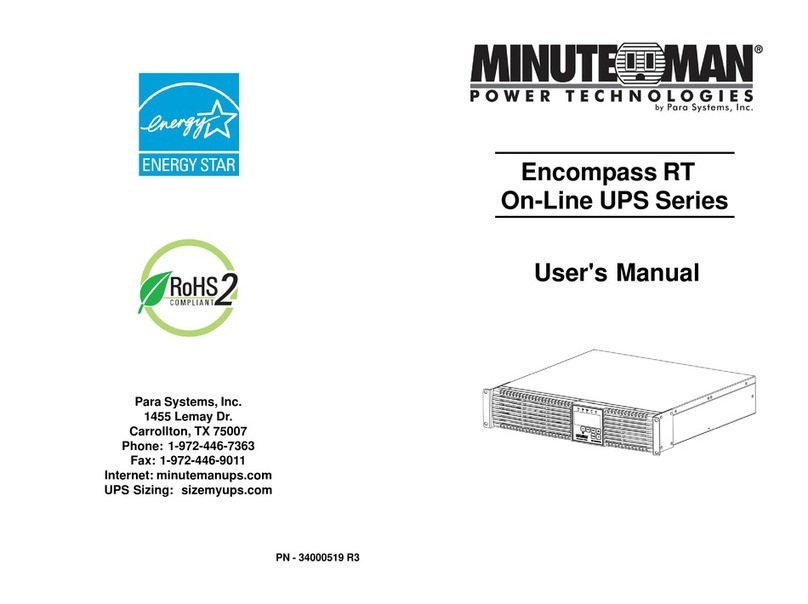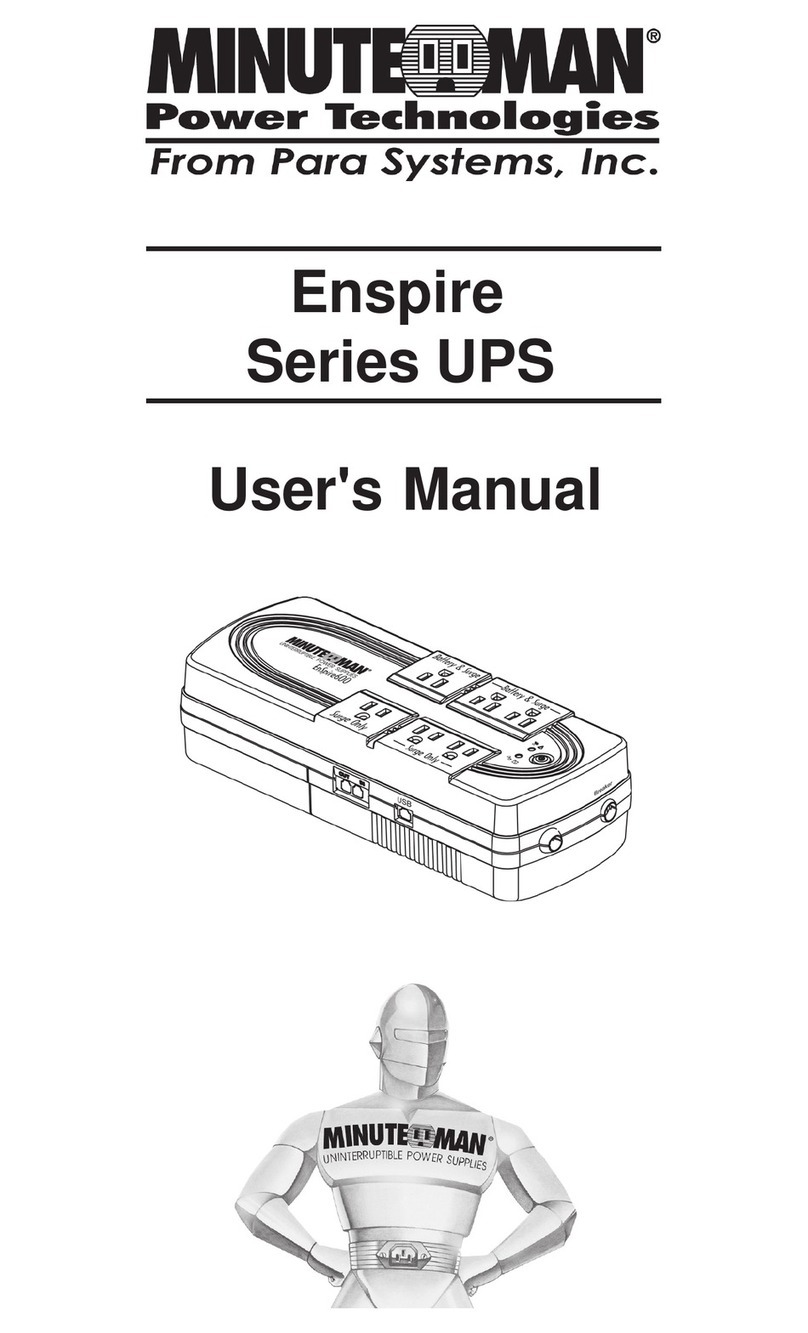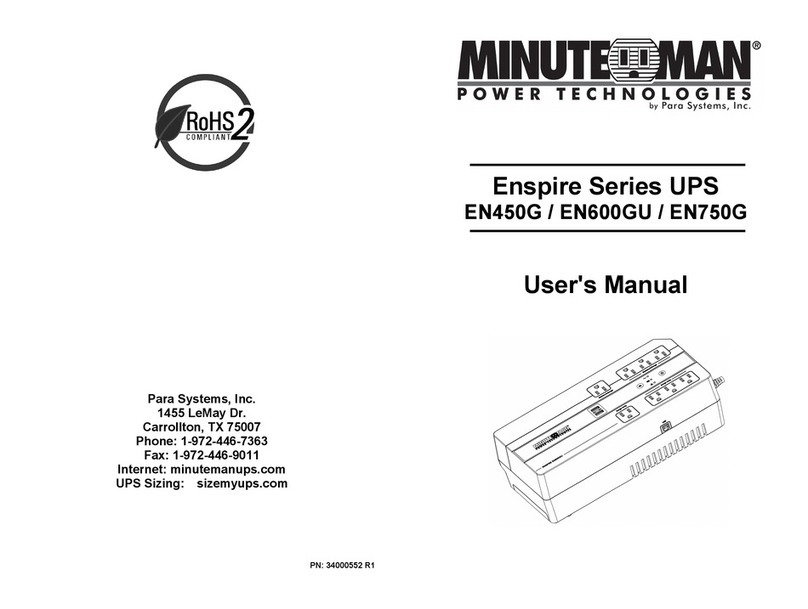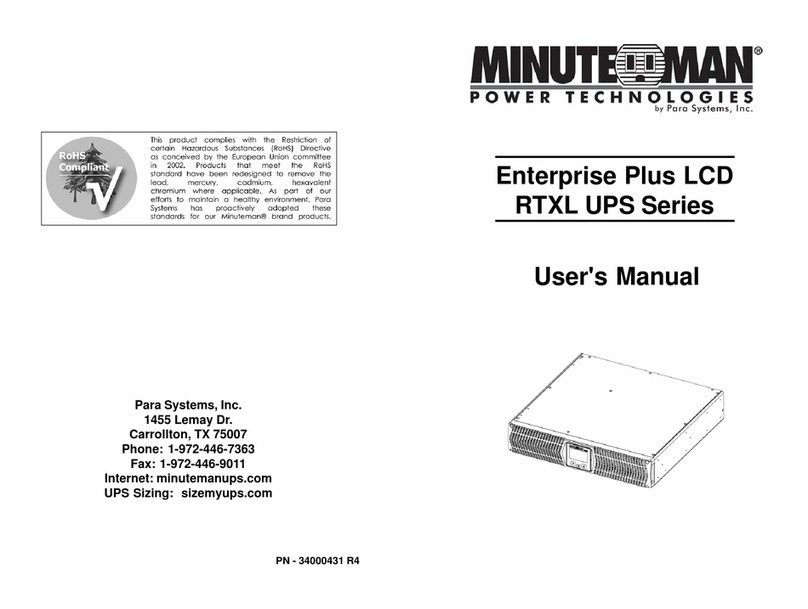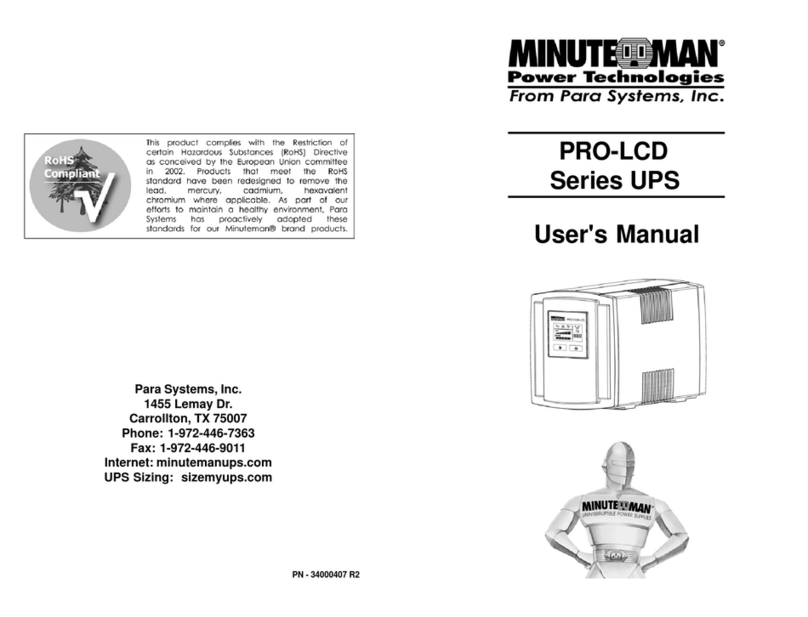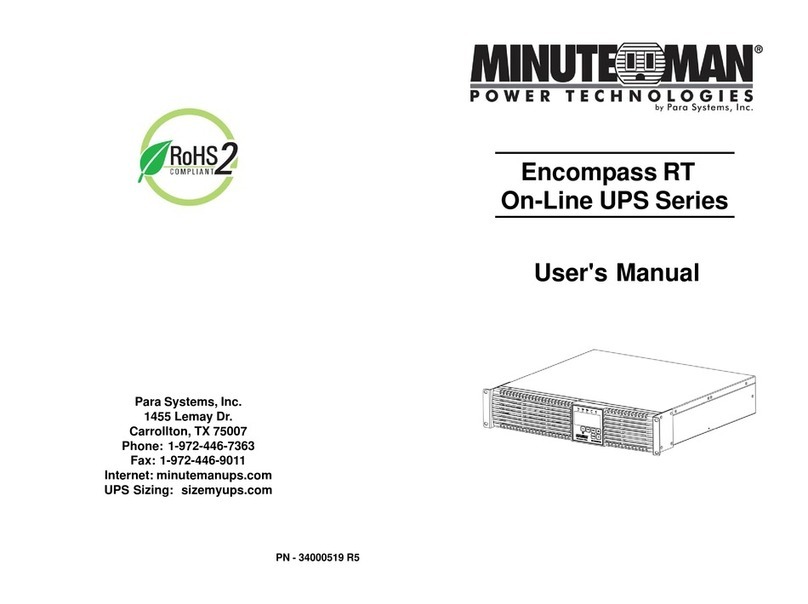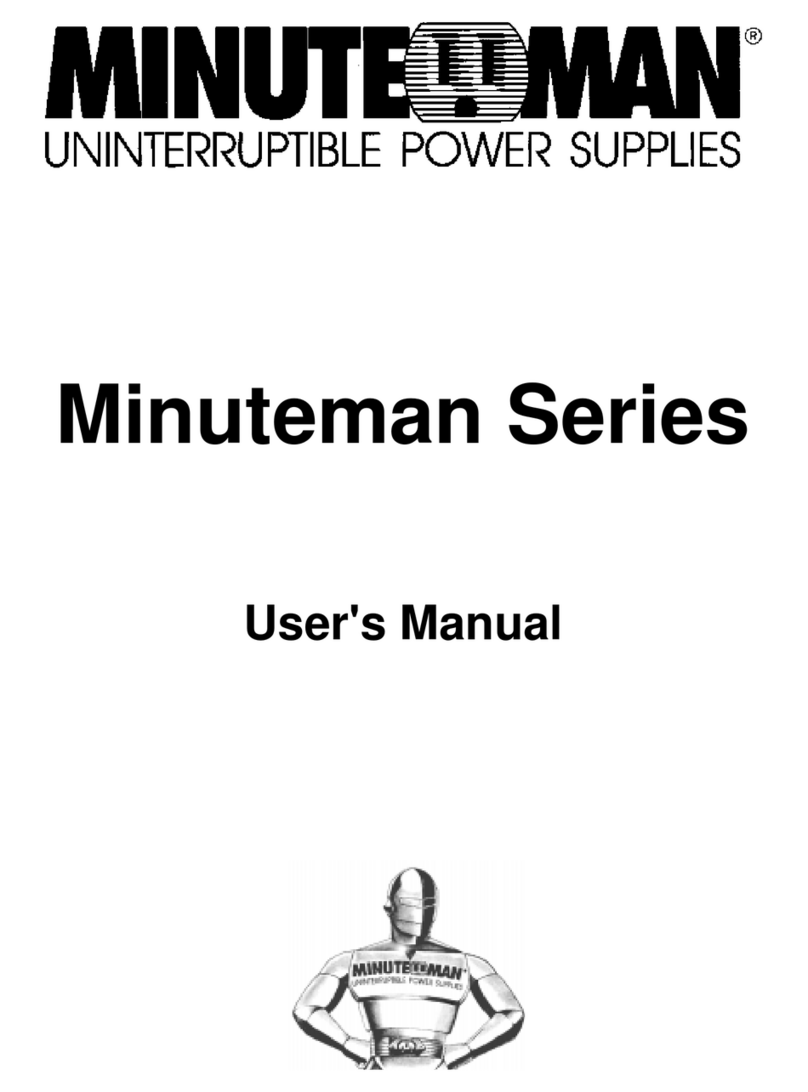14 15
English
English
CHARGINGTHEBATTERY
The UPS will charge the internal batteries whenever the UPS is connected to
anACsourceandthere is an acceptableACvoltagepresent. NOTE: Theinput
circuit breaker MUST be in the on position for the 208V models. It is recom-
mended that the UPS's batteries be charged for a minimum of 4 hours before
use. The UPS may be used immediately, however, the “On-Battery” runtime
may be less than normally expected. NOTE: If the UPS is going to be out of
serviceorstoredforaprolongedperiodoftime, the batteries must be recharged
forat least twenty-four hoursevery ninety days.
COMMUNICATIONS PORT CONNECTION(OPTIONAL)
ThePowerMonitoringSoftwareandinterfacecablescan be used with the UPS.
Use only the interface cables that come with these UPSs. Connect the inter-
facecable (Serial orUSB) to theappropriate communications port on the rear
panelof the UPS. Connect theother end of thecable to thedevice that will be
monitoring/controlling the UPS. NOTE: Connecting to the Communications
Port is optional. The UPS works properly without this connection.
CONNECTINGTHEUPSTOANACSOURCE
PlugtheUPSinto a two pole, three wire,groundedreceptacleonly. Do not use
extension cords, adapter plugs, or surge strips.
NETWORK/PHONE/FAX/MODEMPROTECTION CONNECTION (OPTIONAL)
Connecta10/100Base-T network, single line phone, FaxorModemline to the
RJ11/45 protectionsocketsonthe rear panel of theUPS. This connection will
require another length of telephone or network cable. The cable coming from
the telephone service or networked system is connected to the port marked
“IN”. The equipment to be protected is connected to the port marked "OUT".
NOTE: Connectingto the Network/Phone/Fax/Modem protection socketcon-
nection is optional. The UPS works properly without this connection.
CONNECTINGYOUREQUIPMENT
Plug the equipment into the output receptacles on the rear panel of the UPS.
Do not use extension cords, adapter plugs or surge strips on the output of the
UPS. Ensure that you do not exceed the maximum output rating of the UPS
(referto the information label ontheUPS or the ElectricalSpecifications in this
manual).
CAUTION! DO NOT connectalaserprintertotheoutput receptacles on the
UPS,unlessthe UPS is rated 2000VAorgreater. Alaser printer
draws significantly more power when printing than at idle and
mayoverloadthe UPS.
RJ11 REPO (Remote Emergency Power Off) PORT (OPTIONAL)
Connect one end of the RJ11 cable to the REPO port and the other end of the
RJ11 cable to theEPOswitch. IntheAC or the Batterymodeshortpin4 to pin5
forapproximately0.5-secondstoshutdownthe UPS. The UPS must be turned
off and then back on again to restart the UPS. NOTE: Connecting to the
REPO port is optional. The UPS works properly without this connection.
ON / Test Button
NOTE: The input circuit breaker MUST be in the on position for the 208V
models. Press the ON/Test Button for 1-beep (2-seconds) to turn the UPS on
andsupply power to theload. In theAC modepress the ON/Test Button for1-
beep(2-seconds)toperform a battery test. IntheBattery mode press the ON/
TestButton for 1-beep (2-seconds)tosilencethe audible alarm. TheUPSwill
continue to charge the batteries whenever it is plugged into a wall outlet and
thereis acceptableACvoltagepresent.
SYSTEMOVERVIEW
ThisOn-LineUPS protectscomputers, servers, internetworking, and telecom-
municationsequipmentfrom blackouts, brownouts, overvoltages,andsurges.
This On-Line UPS converts the inputAC to DC and then back to a True Sine
Wave AC output. The True Sine Wave output is regulated within 2% of the
nominaloutput voltage. The Power FactorCorrection (PFC) circuitry corrects
the input power factor to within 97% of unity and blocks the load generated
harmonic distortion from getting back on the inputAC line. This On-Line UPS
provides a continuous true sine wave output with zero transfer time and great
regulationto protect your missioncriticalequipment. The UPS will quietlyand
confidentlyprotect your system frompower anomalies.
TheUPS will charge the batterieswith the UPS intheon or off positionaslong
as the UPS is plugged into the AC wall outlet and there is an acceptable AC
voltage present (80/90 - 138VAC/160 - 280VAC). NOTE: The input circuit
breaker MUST be in the on position for the 208V models. When a blackout,
brownout,or an overvoltagecondition occurs; theUPS will transfer to the bat-
tery mode, the On-Battery indicator will illuminate and the audible alarm will
sound once every ten-seconds indicating that the commercial power is lost or
unacceptable. When the commercial power returns or is at an acceptable
level,theUPSwill automatically transfer back to the normalOn-Linemodeand
start recharging the batteries. During an extended outage when there is ap-
proximatelytwo-minutesofbackuptimeremainingtheaudible alarm will sound
twice every five-seconds. This Low Battery Warning is letting the user know
that they should save all open files and turn off their computer. When the
batteries reach the predetermined level the UPS will automatically shutdown
protecting the batteries from over discharging. Once the commercial power
returns the UPS will automatically restart, providing safe usable power to the
connectedequipment and start recharging thebatteries.

